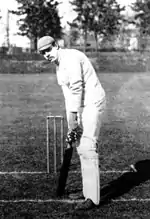Percy Clark
Percy Hamilton Clark (August 7, 1873 – August 12, 1965) was an American cricketer. He was a right-handed batsman and a right-arm fast-medium bowler. He began playing cricket in 1885 and soon found himself at the top of the game in the USA during the brief "Golden Age" of North American cricket.
 | |||||||||||||||||||||||||||
| Personal information | |||||||||||||||||||||||||||
|---|---|---|---|---|---|---|---|---|---|---|---|---|---|---|---|---|---|---|---|---|---|---|---|---|---|---|---|
| Born | August 7, 1873 Germantown, Pennsylvania, U.S. | ||||||||||||||||||||||||||
| Died | August 12, 1965 (aged 92) | ||||||||||||||||||||||||||
| Batting | Right-handed batsman | ||||||||||||||||||||||||||
| Bowling | Right-arm Fast-Medium | ||||||||||||||||||||||||||
| International information | |||||||||||||||||||||||||||
| National side | |||||||||||||||||||||||||||
| Career statistics | |||||||||||||||||||||||||||
| |||||||||||||||||||||||||||
Source: Cricket Archive | |||||||||||||||||||||||||||
Biography
Clark was born on August 7, 1873, in Germantown, Pennsylvania, to Edward White Clark, a member of the Clark banking family, and Mary Todhunter Sill.
Clark played for the USA national team, and took five or more wickets on four occasions in the regular match against Canada, his best being 6/41 in the 1900 game in Manheim. Whilst not known for his batting, he did make two first-class half-centuries. His best was a score of 67, also coming in the 1903 match against Worcestershire where he recorded his best bowling. He often opened the bowling with Bart King when playing for the Philadelphian cricket team and the USA national team. He played 53 first-class matches in all, taking 199 wickets in his career at an average of 21.97, taking 10 wickets in a match four times, and having an innings best of 8/91 against Worcestershire in 1903. The Australian Test spin bowler Arthur Mailey said that by the way Clark imparted spin to the ball he "was able to vary the length of swerve or dictate at which point in its flight the ball would begin to change its course".[1]
Clark received a bachelor's degree from Harvard College in 1892 and, later, a law degree from the University of Pennsylvania. He and his brother, Joseph Sill Clark, Sr., opened a law practice together at 321 Chestnut Street in Philadelphia. His practice centered on the "street railway, electric light, and power businesses" operated by E. W. Clark & Co., his family's financial firm.[2]
Family
He married Elizabeth Williams Roberts (1879–1959), daughter of George Brooke Roberts, the president of the Pennsylvania Railroad[3] in 1904.[4]
In 1908, George Roberts gave the couple some of his land along Belmont Avenue in Bala Cynwyd, Pennsylvania. They commissioned a cousin, Clarence C. Zantzinger, to design a mansion, which they named "Willoughby." Household staff included a houseman, cook, scullery maid, waitress, governess, a nurse, chambermaid, two gardeners, a farmer, and a driver. They added a chauffeur's cottage and a barn, which supported a small working farm with seven cows, one horse, and 400 chickens.[4][5]
Percy and Elizabeth Clark had eight children, including John Clark[4] and Mary Todhunter "Tod" Clark (1907–1999), who in 1930 married the future New York governor and U.S. vice president Nelson Rockefeller.
"Tod" and Nelson had five children: Rodman Rockefeller, Anne Rockefeller, Steven Clark Rockefeller, and twins Michael Clark Rockefeller and Mary Rockefeller. They divorced in 1962, which was considered to have hurt Nelson's 1964 bid to become the GOP's candidate for U.S. president.[3]
Percy Clark died on August 12, 1965.
References
- Arthur Mailey, 10 for 66 and All That, Phoenix, London, 1958, pp. 114–15.
- "Secretary's 4th Report". Harvard College: Class of 1896. 4: 64–65. June 1911.
- Hutto, Richard Jay; June Hall McCash; Stillman Rockefeller (2005). Their Gilded Cage: The Jekyll Island Club Members. Macon, Georgia: Henchard Press. p. 36. ISBN 9780977091225. Retrieved December 8, 2010.
- "Part 28: The Residents: Percy Clark's Willoughby". The First 300: The Amazing and Rich History of Lower Merion. The Lower Merion Historical Society. Retrieved September 26, 2013.
- In 1951, the mansion was sold to the Mary J. Drexel Home, a nursing home named for Mary Johanna Drexel (1822–1873), a daughter of Francis Martin Drexel. NYT obituary for Mary's husband, John D. Lankenau, August 31, 1901
External links
- List of Canada v USA matches
- Cricket Archive profile
- Profile at CC Morris Cricket Library
- Cricinfo profile
- 1930 photo of Clark posing with John D. Rockefeller at Nelson and Mary's wedding.